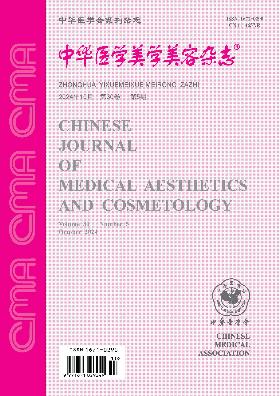Clinical efficacy and key points of individualized breast augmentation via inframammary fold incision
引用次数: 0
Abstract
Objective To explore the key points of surgical techniques in individualized breast augmentation via inframammary fold (IMF) incision. Methods Fifty-six patients of our department from March 2014 to March 2017 in this group were followed up for 3-18 months, with average 12 months. According to the patients' characteristics to determine the size and dimensions of the implant and the exact position of new IMF, via IMF incision we inserted an implant part under the pectoralis major muscle and part posterior to the breast after precisely stripping and forming the implant pocket, which were the dual-plane augmentation mammoplasty. Results Compared with traditional endoscope-assisted breast augmentation via axillary incision, the breast augmentation via inframammary fold incision was more accurate, the operation time was shortened by an average of one hour, the intraoperative hemorrhage decreased by about 20 ml on average, the postoperative drainage fluid was reduced by about 70 ml on average, the hospitalization time was shortened by about 3 days, the postoperative breast shape was naturally upright, and the incision was hidden at the new inframammary fold. No hematoma, infection, significant hypertrophic scar, capsule contracture and other complications were noted. Conclusions The individualized dual-plane augmentation mammoplasty via IMF incision can hide the incision in the inframammary fold. The operation under direct vision and no use of special equipments make it an ideal breast augmentation surgery. Key words: Breast implantation; Prosthesis implantation; Micromastia; Mastoptosis; Inframammary fold乳房下褶切口个体化隆胸的临床疗效及要点
目的探讨乳房下褶切口个体化隆胸的手术技术要点。方法本组于2014年3月~ 2017年3月对我科56例患者进行随访,随访时间3 ~ 18个月,平均12个月。根据患者的特点,确定假体的大小尺寸及新IMF的确切位置,经IMF切口在胸大肌下方和乳房后方置入假体部分,精确剥离并形成假体袋,即双平面隆乳术。结果与传统内窥镜辅助下经腋窝切口隆胸相比,经乳下褶切口隆胸更准确,手术时间平均缩短1小时,术中出血量平均减少约20 ml,术后引流液平均减少约70 ml,住院时间缩短约3天,术后乳房形态自然挺拔。切口隐藏在新的乳下褶处。无血肿、感染、明显增生性瘢痕、包膜挛缩等并发症。结论个体化经IMF切口双平面隆乳术可隐蔽乳腺下襞切口。在直视下操作,无需特殊设备,是理想的隆胸手术。关键词:乳房植入术;假体植入;小乳房;乳房下垂;Inframammary褶皱
本文章由计算机程序翻译,如有差异,请以英文原文为准。
求助全文
约1分钟内获得全文
求助全文
来源期刊
自引率
0.00%
发文量
4641
期刊介绍:
"Chinese Journal of Medical Aesthetics and Cosmetology" is a high-end academic journal focusing on the basic theoretical research and clinical application of medical aesthetics and cosmetology. In March 2002, it was included in the statistical source journals of Chinese scientific and technological papers of the Ministry of Science and Technology, and has been included in the full-text retrieval system of "China Journal Network", "Chinese Academic Journals (CD-ROM Edition)" and "China Academic Journals Comprehensive Evaluation Database". Publishes research and applications in cosmetic surgery, cosmetic dermatology, cosmetic dentistry, cosmetic internal medicine, physical cosmetology, drug cosmetology, traditional Chinese medicine cosmetology and beauty care. Columns include: clinical treatises, experimental research, medical aesthetics, experience summaries, case reports, technological innovations, reviews, lectures, etc.

 求助内容:
求助内容: 应助结果提醒方式:
应助结果提醒方式:


